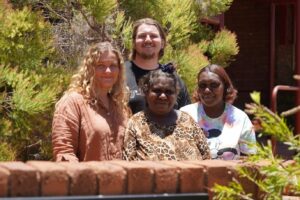Rare recording of ‘mysterious’ night parrot song made by Indigenous rangers in Gibson Desert
Charmayne Allison and Meredith Lake
Sat 16 Dec 2023
Indigenous rangers have captured a rare recording of the “extremely secretive” night parrot in a remote part of Western Australia.
Described as the “holy grail” of ornithology, the elusive bird was rediscovered in 2013, more than a century after it was last seen.
Today, researchers say there are about a dozen sites in the entire country where the night parrot is known to occur.
The bird’s call was recently recorded by the Kiwirrkurra ranger team in a remote area of the Gibson Desert, 700 kilometres west of Alice Springs.
Rangers said the exact location would be kept a secret, as efforts to protect the critically endangered bird continue.
The discovery makes Kiwirrkurra the fifth Indigenous ranger team in the country to have successfully detected the night parrot.
Nolia Yurrkultji Ward hadn’t heard the call of the night parrot since she was a little girl.
(ABC Alice Springs: Xavier Martin)
For Pintupi woman Nolia Yurrkultji Ward, a Kiwirrkurra traditional owner, it is the first time she has heard the bird’s call since she was a little girl.
“I feel really happy, really excited,” she said.
A significant discovery
This year, Kiwirrkurra rangers erected five sound meters in remote areas of country where they thought night parrots might live.
They recorded for more than a month, with the audio then analysed by University of Queensland night parrot expert Nick Leseberg.
He said the discovery of the night parrot’s “predictable calling sequence” was significant.
“Every time we get a new dot on the map, that extends the range of the night parrot just a little bit further. It’s critical,” he said.
Night parrot expert Nick Leseberg says it’s rare to spot the elusive bird.
(Supplied: Andrew Dawson)
Dr Leseberg said the “mysterious” birds spent the day nesting in the bottom of spinifex hummocks and only came out at night.
However, the night parrot’s habitat has been threatened in recent decades, with the bird preferring to live in spinifex which has been unburnt for a “really long time”.
“Over the last 200 years there have been lots of cats, lots of inappropriate fire, so there’s not much habitat for them,” Dr Leseberg said.
As for the exact number of remaining night parrots, he said this was the “million-dollar question” – but it was likely “a few hundred”.
Janine West and Conway Gibson erect song meters to detect the night parrot’s call.
(Supplied: Tjamu Tjamu Aboriginal Corporation)
Community ‘excited’ to hear bird call
When Ms Ward and her siblings were growing up on country, her mother would tell them to go to sleep when they heard the night parrot’s song.
They would swiftly obey, worried it was a “mamu” – an evil spirit.
But she said for a long time, she did not hear the night parrot’s call, until now.
Kiwirrkurra ranger Conway Gibson said he had been excited when he heard the bird’s call for the first time.
He said in the wake of the discovery, the ranger team would be working hard to protect the night parrot from feral animals and bushfires.
“They’re a rare bird that hasn’t been seen for a while. Back in old days they’d probably see it,” he said.
“That’s why we’re trying to look after them, get more numbers in coming years.”
Scott West (left) and Ed Blackwood analyse audio data from the field.
(Supplied: Rachel Paltridge)
Western science, Indigenous wisdom
Since 2016, Dr Leseberg has been working to refine detection methods for the night parrot, in recent years passing on his knowledge to Indigenous ranger groups, including Kiwirrkurra.
This has led to the species being located at several new sites, particularly in central Western Australia, with about half the sites over the past decade found by Indigenous rangers.
Dr Leseberg said this highlighted the power of marrying western science with Indigenous knowledge.
“I don’t know the country out there, I couldn’t use this,” he said.
“But by giving the rangers this knowledge, they could combine it with their knowledge of country.”
Kiwirrkurra ranger coordinators Dannika and Ed Blackwood with traditional owner Nolia Yurrkultji Ward and daughter Lydia.
(ABC Alice Springs: Xavier Martin)
This latest discovery means Kiwirrkurra rangers are now working to protect four threatened species, including the princess parrot, ninu (bilby) and tjalapa (great desert skink).
“It made me really excited that the night parrot still exists there, because it means we’re doing lots of good work,” Kiwirrkurra ranger coordinator Ed Blackwood said.
“If that’s there, it means lots of other animals can live and be happy in that same area.”





